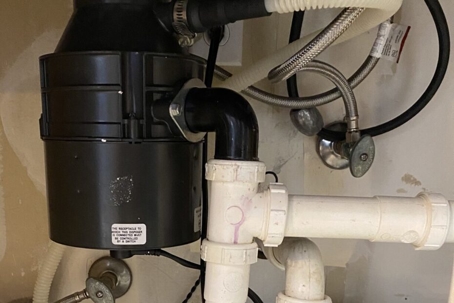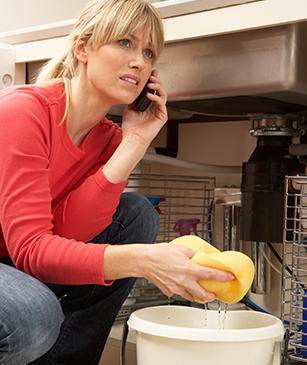Leading Tips for Fixing a Leaking Waste Disposal Unit
Leading Tips for Fixing a Leaking Waste Disposal Unit
Blog Article
The article author is making a number of good points on Garbage Disposal Leaking From Bottom in general in this great article on the next paragraphs.

Waste disposal unit are crucial kitchen appliances that assist in throwing away food waste successfully. Nonetheless, a dripping waste disposal unit can be an irritating and unpleasant trouble to take care of. Luckily, lots of leaks can be fixed conveniently with a couple of easy steps. In this write-up, we will discuss just how to take care of a leaking waste disposal unit efficiently.
Intro
Garbage disposals are mounted under kitchen area sinks and are made to shred food waste into smaller pieces, allowing it to pass through the plumbing system quickly. While these gadgets are generally reliable, leakages can occur gradually as a result of damage, loosened links, or damages to the system.
Usual Root Causes Of Leakages in Waste Disposals
Worn Seals and Gaskets
Seals and gaskets play an important duty in protecting against water from leaking out of the garbage disposal. Over time, these components can deteriorate, leading to leakages around the disposal device.
Loose Connections
The connections in between the waste disposal unit and the plumbing system can become loosened gradually, causing water to leakage out during operation.
Fractures or Holes in the Disposal Device
Physical damage to the waste disposal unit, such as fractures or openings in the housing, can additionally result in leakages.
Identifying the Resource of the Leakage
Before trying to fix a leaking waste disposal unit, it is important to identify the resource of the leak. This can usually be done with visual examination or by carrying out easy tests.
Visual Evaluation
Inspect the garbage disposal device carefully for any kind of signs of water leakage. Pay very close attention to areas around seals, gaskets, and connection points.
Testing for Leakages
One method to evaluate for leaks is by running water via the disposal system and looking for any kind of visible signs of leak.
Devices and Materials Needed for Fixing a Dripping Waste Disposal Unit
Before starting the repair service process, collect the required tools and materials, including a screwdriver, flexible wrench, plumbing's putty, substitute seals or gaskets, and epoxy or patching material for fixing splits or holes.
Step-by-Step Overview to Fixing a Leaking Waste Disposal Unit
Turn Off the Power
Before attempting any kind of repairs, guarantee that the power to the waste disposal unit unit is switched off to stop the threat of electric shock.
Locate the Leak
Determine the precise place of the leakage and figure out the reason.
Tighten up Links
Use a wrench to tighten up any kind of loose links in between the disposal system and the pipes system.
Replace Seals or Gaskets
If the leak results from used seals or gaskets, get rid of the old components and change them with new ones.
Patching Fractures or Holes
For cracks or openings in the disposal unit, use epoxy or an ideal patching product to secure the broken area.
Examining the Garbage Disposal After Repair Service
Once the repair service is complete, check the garbage disposal by running water with it to make certain that the leak has actually been solved.
Preventive Maintenance Tips to Stay Clear Of Future Leakages
To stop future leakages, it is necessary to perform normal maintenance on your waste disposal unit. This includes maintaining it clean, staying clear of putting non-food things or hard things down the disposal, and periodically checking for leaks or other concerns.
Conclusion
To conclude, fixing a leaking garbage disposal is a fairly uncomplicated procedure that can be finished with fundamental tools and materials. By adhering to the steps outlined in this short article and exercising preventive upkeep, you can maintain your waste disposal unit in good working condition and prevent expensive repair services in the future.
HERE’S HOW TO FIX YOUR GARBAGE DISPOSAL
WHAT TO DO IF SOMETHING IS STUCK IN YOUR GARBAGE DISPOSAL
If the impeller won’t turn, there’s probably something stuck in the disposal. It could be a steak bone or peach pit, although plumbers report pulling all sorts of inappropriate objects out of disposals, such as bottle caps or aluminum foil. Make sure power to the disposal is off, and look inside to see if you can see the source of the jam.
Never stick your fingers in a disposal. Pull out anything you see with tongs or pliers.
If the disposal still won’t work, it may be time to call a plumber or consider buying a new disposal. GEM Plumbing & Heating is here for all of your garbage disposal needs.
WHAT TO DO IF YOUR GARBAGE DISPOSAL DRAIN IS CLOGGED
Take everything out from underneath your sink and put a bucket or other container under your disposal to catch any water that drains out. Disconnect your disposal from the power supply. If it’s plugged into a wall outlet, unplug it. If it’s hardwired into an electrical box, go to the electrical panel and turn off the breaker for the disposal. Pour ¼ cup of baking soda into the drain, followed by ½ cup of white vinegar. Give the solution a few minutes to fizz and do its work. Look into the disposal with a flashlight to see if you can see an object that might be causing the clog. If you see it, remove it using tongs or pliers. MORE TIPS ON DEALING WITH A CLOGGED GARBAGE DISPOSAL
Never use drain cleaner in a garbage disposal. It can damage the plastic parts inside the disposal. You can also be splashed with the caustic liquid while working to clear the clog. Beware! Never stick your fingers into a garbage disposal. Trust us — not a good idea. In many instances, your dishwasher drains through your garbage disposal. This allows the disposal to grind any large food particles that may be drained out of your dishwasher. There are some jurisdictions, however, where the plumbing code prohibits such a connection. WHAT TO DO WHEN YOUR DISHWASHER DRAINS THROUGH THE DISPOSAL
Run some water in the sink so your plunger has at least a ½-inch of water to create a seal and plunge vigorously up and down several times. You may need to repeat this several times. Run hot water down the drain to clear any residue that remains.

I'm very taken with Why Is and I really hope you enjoyed reading the blog entry. Are you aware of another person who is interested by the subject? Take a moment to promote it. I take joy in reading our article about Garbage Disposal Leaking From Bottom.
Visit Site Report this page